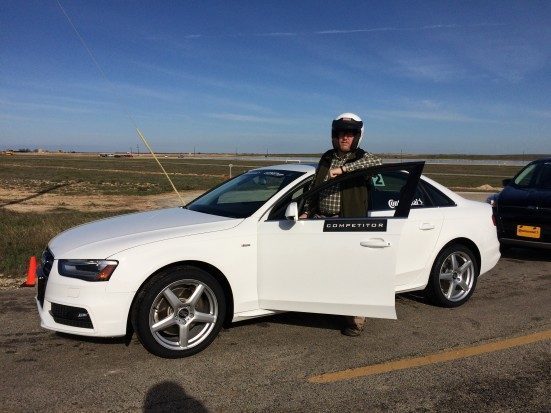Texas Tire Torture | Conti DWS06 review
I’ve been on a few wide-ranging trips with the German-based automotive supplier Continental, covering everything from vehicle-to-vehicle communication to collision avoidance systems, in locales from Detroit, Michigan, to Regensburg, Germany. But my most recent outing with the company was tightly focused on one product: the new Continental ExtremeContact DWS06 ultra-high performance all-season tire. That’s a mouthful, so let’s break down why this might matter to you.

Audi’s all-wheel-drive A4 provided a perfect platform for testing Continental’s new tire.
Why Continental Tires?
First, this is Continental’s first all-new tire in this segment since 2009, in a part of the car and SUV market where all the big luxury brands play. If you own or are considering purchasing a luxury vehicle, you might eventually want to put these tires on your car.
Second, this is a stunningly good tire, with great traction in both wet and dry conditions. I got a chance to put the tire through its paces as part of a media program hosted by Continental’s tire experts at the company’s sprawling 5,000-acre Uvalde tire proving grounds west of San Antonio, Texas.
Smokin' OPs @BeCarChic #ForWhatYouDo pic.twitter.com/xrEkGL5VEL
— Bob Gritzinger (@bobgritzinger) March 11, 2015
The program featured a series of wet and dry track tests, driving a range of vehicles including the Audi A4, BMW 235i, Ford Escape, Ford Mustang and Mini Cooper S. Identical cars were fitted with the new ExtremeContact DWS06, the previous-generation ExtremeContact DWS, or comparable competitors’ all-season tires including the Bridgestone Potenza RE970, Goodyear Eagle F1 Asymmetrical, Michelin Pilot Sport, Pirelli Scorpion Verde, and the Yokohama ADVAN Sport.
While the home team obviously gets to choose which competitor to match up against in each challenge, it is safe to say that some of the competition fared better than others.
Image credit: Continental Tire
Super Wet Traction
Continental’s new rubber shone brightest in the wet, where its trademarked Monoblock tread design helped to create a noticeably higher level of lateral grip on slippery, wet pavement. The specialized tread combines with the tire’s outer shoulder tread to produce a highly predictable and communicative level of traction at the limit.
This is a desirable trait in a tire because it gives the driver enough information and time to react to prevent total loss of traction—and it doesn’t “snap” back abruptly when traction is regained. The new Continental also exhibited superior traction under acceleration and in hard braking on wet surfaces, typically stopping up to 10 feet shorter than competitors in my testing.
On dry pavement, where all high-performance tires should excel, the new DWS06 still proved superior, though I noted what felt like some lateral softness in hard cornering versus some of the competitors’ stiffer rubber. But again, that quality tended to translate into a predictable level of traction up and past the limit, rather than the more “on/off” traction of other tires in the mix. I’d also add that, in normal driving, you’ll probably never find yourself finding the limit of this tire on dry roads—as we deliberately did—and you’ll appreciate the softer ride over the long haul.
This Monoblock tread combines with the tire’s shoulder to provide extra lateral traction.
Finally, there’s a third part to the DWS06 name—that “S” is for Snow (“D” for Dry, “W” for Wet). We didn’t get a chance to sample the tire in frozen conditions, but Continental says its testing shows top performance when the white stuff flies. We’d sure love a chance to give it a go.
Here’s a cool feature, by the way: Conti builds D, W, and S indicators right into the tread, so that as each letter wears away the owner can visually “read” the approximate traction level to expect from his or her tires in different conditions.
Continental’s ExtremeContact DWS06 tire goes on sale in May in most sizes, with the rest arriving by September. The company says pricing should be comparable to the current DWS line, despite the new tire’s demonstrated improvement over the previous model.




